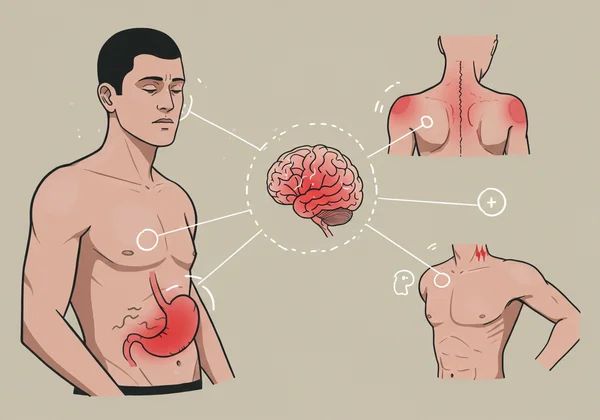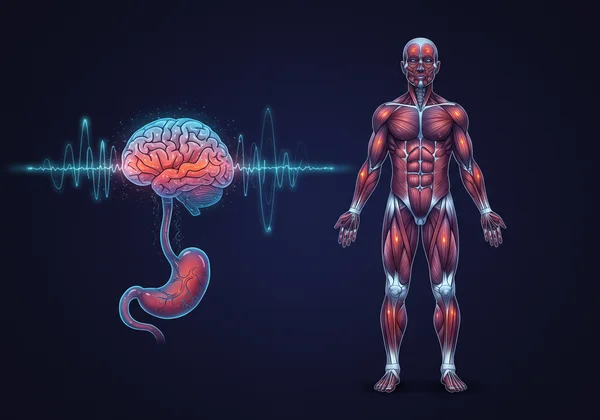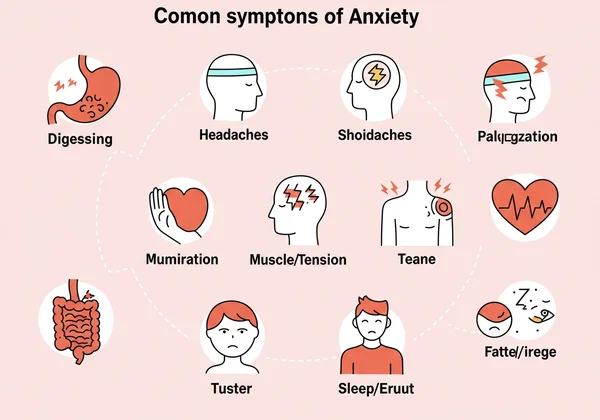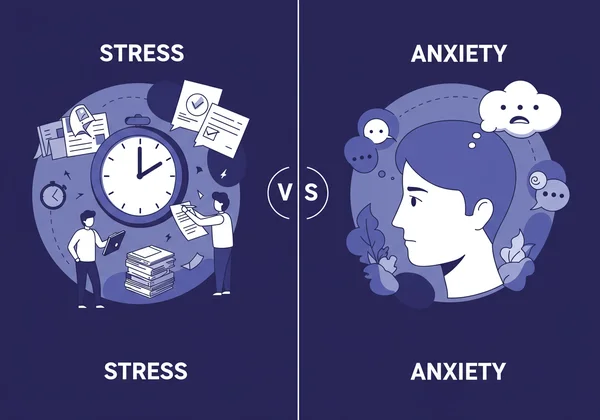揭示焦虑的身体症状:通过焦虑测试获得清晰认知
感到不明原因的疼痛、持续的疲劳或胃部翻腾吗?你并不孤单。许多人经历了一系列身体症状,他们将其归因于“只是压力”,却不知道这些可能是焦虑的潜在信号。如果你曾想过,我是焦虑还是只是压力大? 本指南将深入探讨焦虑常见的身体表现,并教你如何将其与日常压力区分开来,从而助你迈出寻求清晰认知和缓解的第一步。如需保密地了解自己的症状,你随时可以通过自我评估 获得即时洞察。

身心联系:焦虑如何影响你的身体
焦虑不仅仅是一种担忧或恐惧的感觉;它是一种全身心的体验。当你的大脑感知到威胁时——无论是真实的危险还是对工作截止日期的持续担忧——它都会触发一系列复杂的生理反应。这种根深蒂固的生存本能解释了为什么情绪困扰会让人感到如此身心俱疲。理解这种联系是识别焦虑对你健康潜在影响的关键,而自我评估焦虑测试通常是第一步。

理解“战或逃”反应
焦虑身体症状的核心是 战或逃反应。这是你身体的自动警报系统,由交感神经系统管理。当它被触发时,会让你准备好对抗威胁或逃离威胁。你的心率会加快,呼吸会急促,感官会变得敏锐。虽然在逃避即时危险时非常有用,但慢性焦虑会使这个系统处于高度戒备状态,导致即使没有真正的威胁存在,身体也会持续承受压力和不适。
荷尔蒙的作用:皮质醇和肾上腺素
战或逃反应会使你的身体涌入大量应激激素,主要是 皮质醇和肾上腺素。肾上腺素会给你带来即时的能量激增,提高心率和血压。皮质醇,即“应激激素”,有助于调节能量,让你在更长时间内保持警觉。短期内,这很有帮助。但当焦虑是慢性时,长期暴露于皮质醇水平升高会扰乱你身体的几乎所有过程,导致消化问题、头痛、睡眠问题和免疫系统减弱。
焦虑的常见身体症状解析
尽管每个人经历焦虑的方式不同,但某些身体症状是常见的。这些并非“都是你想象出来的”;它们是心理困扰引起的真实生理反应。识别它们是有效管理它们的第一步,通常从全面的焦虑测试开始。

消化道不适:恶心、肠易激综合征和胃痛
你的肠道常被称为“第二大脑”,因为它对心理压力高度敏感。焦虑是 消化问题 的主要诱因。应激激素的激增会扰乱消化,导致恶心、胃痉挛、腹泻或便秘。对许多人来说,这表现为肠易激综合征(IBS),一种与焦虑密切相关的疾病。频繁的胃痛且没有明确的医学原因,可能是你焦虑心态发出的身体信号。
头痛和肌肉紧张:无声的挤压
你是否发现自己的肩膀总是很紧,或者经常出现紧张性头痛?这是焦虑的典型症状。在战或逃反应期间,你的肌肉会紧张起来,为行动做好准备。当你长期焦虑时,这种 肌肉紧张 会变得持续存在,导致颈部、肩膀和背部持续酸痛。这种持续的紧绷也是紧张性头痛的主要原因,感觉就像有一条紧绷的带子勒住你的头部。
心血管问题:心悸和胸闷
焦虑一些最令人担忧的身体症状涉及心脏。你可能会感到心跳加速、心慌或出乎意料的心脏猛跳(心悸)。你也可能会经历突发的剧烈疼痛或胸部紧绷感。这些感觉通常是由肾上腺素激增和焦虑引起的急促呼吸所致。虽然令人警觉并与心脏病发作症状相似,但当焦虑是根本原因时,它们通常是无害的。
疲劳和睡眠障碍:当休息不足时
同时感到亢奋和疲惫是许多焦虑症患者深有体会的矛盾。一个无法停止思考的大脑使人难以入睡或保持睡眠,导致失眠和 睡眠问题。即使你得到了一些休息,持续的高度警觉状态也会让人身心俱疲。这可能导致慢性疲劳,无论你如何尝试休息都无法改善。
头晕、震颤和麻木:超越显而易见的症状
焦虑还会引起令人不安的神经系统样症状。 头晕或头重脚轻 的感觉可能由于呼吸模式改变(如过度换气)而发生。你可能还会注意到手部颤抖或震颤,这是肾上腺素激增的直接结果。有些人甚至会感到手脚刺痛或麻木,这种感觉是由于在应激反应期间血液被重新分配到更大的肌肉群所致。
气短和过度换气
感觉无法呼吸是焦虑和恐慌发作的典型症状。这种 气短 常常导致过度换气(呼吸过快和过浅),进而可能引起头晕和胸闷等其他症状。这是一个恶性循环,症状本身会加剧焦虑,使呼吸变得更加困难。
是压力还是焦虑?需要注意的关键区别
尽管压力和焦虑有许多共同的身体症状,但它们并非一回事。压力通常是对外部诱因(例如,一个紧迫的截止日期)的反应,而焦虑是一种持续的、过度的担忧,即使没有明确的压力源也会持续存在。如果你不确定自己属于哪种情况,在线焦虑测试 可以提供有价值的参考。

症状的持续时间和强度
主要区别在于持续时间和强度。压力症状通常在外部诱因消除后消退。例如,你的紧张性头痛可能会在完成一个困难项目后消失。而焦虑的身体症状可以持续数周或数月,通常没有明显的原因。其强度也可能与当前情况不成比例。
对日常功能的影响
考虑一下你的症状如何影响你的生活。日常压力可能会让你暂时感到不知所措,但你通常仍然可以正常运作。而焦虑则可能使人衰弱。如果你的身体症状导致你回避社交场合、缺勤或难以完成日常任务,这更可能是焦虑症的迹象。一份保密的 焦虑评分 可以帮助量化这种影响。
何时应认真对待你的身体症状
你的身体正在发出重要信号。忽视持续的身体症状会对你的长期健康造成影响,因此知道何时采取行动至关重要。
排除其他医疗状况
首先,咨询医疗专业人员至关重要,以排除任何可能导致你症状的潜在医疗状况。医生可以进行体格检查和任何必要的测试,以确保你的心脏、消化系统和其他功能健康。坦诚你的情绪状态可以帮助他们做出准确的评估。
你迈向理解和缓解的第一步
一旦排除了其他医学原因,理解症状的心理根源就是下一步。这时,经过验证的焦虑测试就成为一个强大的工具。它提供了一种私密、无压力的探索方式,帮助你探索心理感受与身体体验之间的联系。获得这种洞察力可以成为你寻求进一步支持或实施有效应对策略的动力。你准备好了解更多了吗?现在就 开始你的自我评估。
你的清晰与平静之路
了解你的身体症状可能源于焦虑,是迈向缓解的关键第一步。现在你对焦虑如何表现在身体上有了更清晰的认识,从消化道不适到肌肉紧张,以及如何将其与日常压力区分开来。这种理解使你能够真正倾听自己的身体,并优先考虑你的健康。
不要让不确定性阻碍你获得更好的感觉。如果你怀疑焦虑可能正在影响你的身心健康,进行一项保密的焦虑测试可以提供有价值的见解。今天就 参加我们的免费测试——它是匿名的、有科学依据的,并提供即时、个性化的结果,以指导你迈向更平静、更健康的自己。
关于焦虑身体症状的常见问题
我是焦虑还是只是压力大?
压力是对特定、可识别诱因的短期反应,其症状通常在压力源消失后得到缓解。焦虑的特点是即使没有明确的诱因,也会持续存在过度担忧,其身体症状可能是慢性的,并扰乱日常生活。
焦虑的 5 个常见身体迹象是什么?
尽管症状各异,但焦虑的五个最常见身体迹象是:1) 心跳加速或心悸,2) 消化问题,如胃痛或恶心,3) 慢性肌肉紧张和头痛,4) 气短,以及 5) 持续疲劳和睡眠问题。
如果我只有身体症状,如何自我测试焦虑?
经过科学验证的筛查工具,如我们的测试所依据的 GAD-7,旨在通过询问情绪和身体体验来评估焦虑。问题通常涵盖坐立不安、易怒和无法控制的担忧,这些都与你可能感受到的身体症状密切相关。一份 保密的焦虑测试 可以将你的身体感受与常见的焦虑模式联系起来。
在线焦虑测试对身体症状的准确性如何?
基于 GAD-7 等临床量表的高质量在线焦虑测试是一个高度可靠的筛查工具,而非诊断工具。它旨在准确衡量常见焦虑症状(包括身体症状)的严重程度,以帮助你了解自己的经历是否与焦虑症的症状相符。它是自我认知的重要第一步,也是与医疗专业人员进行对话的良好开端。